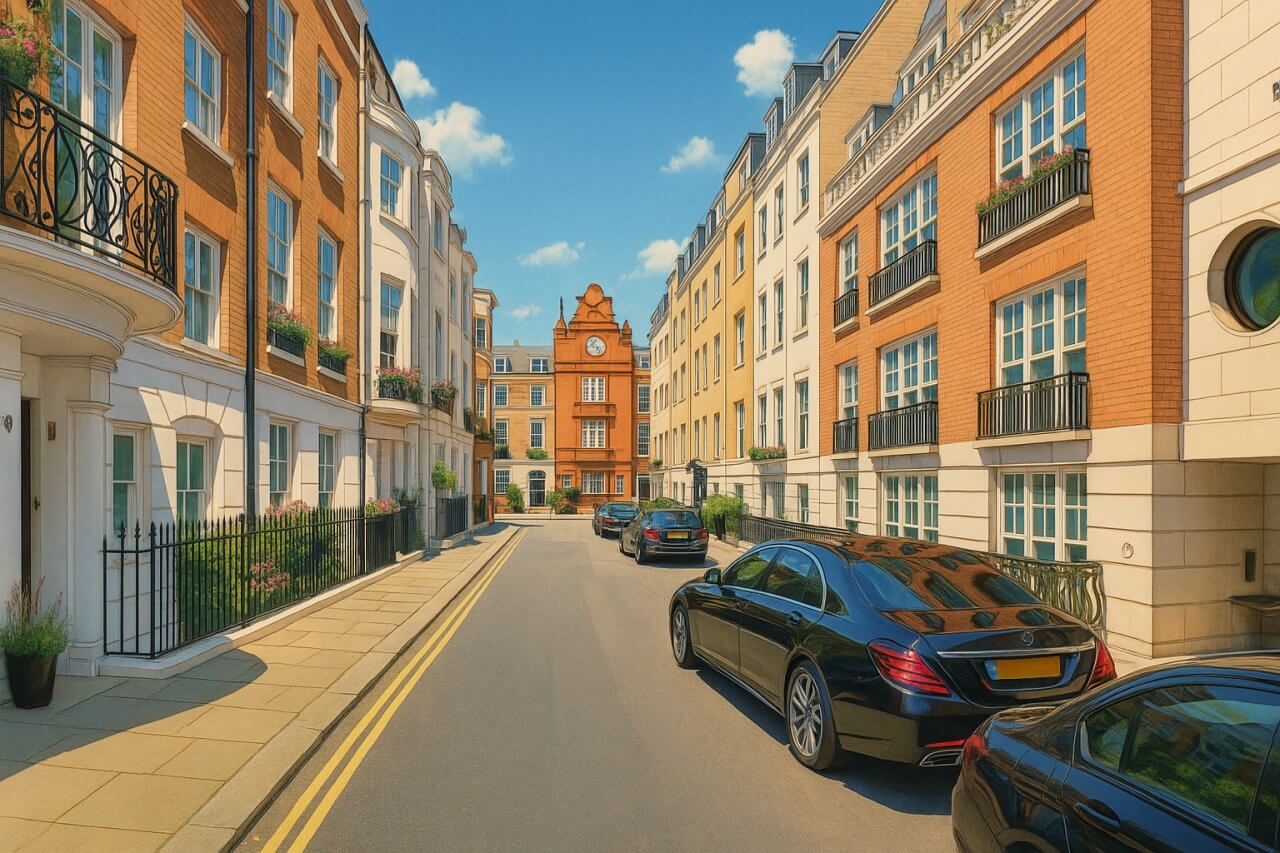
Tilney Street, London
Tilney Street is a short but historically significant street located in the heart of Mayfair, within the City of Westminster, London. Running in a single eastbound direction, Tilney Street begins at Deanery Street and leads directly to South Audley Street. The atmosphere is genteel and refined, with discreet entrances to high-value residential and commercial properties, reflecting Mayfair’s prestigious character.
Street Layout and Surroundings
Tilney Street measures only about 120 metres (394 feet) in length, and while it may appear modest in scale, it is enveloped by some of the most exclusive addresses in London. The street is a one-way road, with traffic flowing from Deanery Street in the west to South Audley Street in the east. Nearby streets include the elegant Park Street to the north and Stanhope Gate to the south. The entire vicinity exudes the calm and affluent energy typical of central Mayfair.
Due to its central location and limited public visibility, Tilney Street has a quiet, almost secretive quality. Despite this, it is only steps away from some of London's most celebrated shopping destinations, parks, and cultural institutions.
Historical Background
The area that includes Tilney Street was developed in the 18th and 19th centuries as part of the Grosvenor Estate expansion in Mayfair. While the street itself is not as widely chronicled as neighbouring avenues, it formed part of the structured grid of elegant residential streets developed by the Grosvenor family. Early maps indicate that Tilney Street was likely laid out in the mid-19th century, at a time when Mayfair was transitioning from a semi-rural aristocratic enclave to a well-structured urban neighbourhood for the elite.
Origin of the Name
The origin of the name "Tilney Street" is not definitively recorded, but it may refer to the Tilney family, a prominent English family with aristocratic connections. Another possible link is to the Norfolk village of Tilney, possibly reflecting land ownership or historical ties known to the developers of the area. The name was in place by the mid-1800s, as evidenced by contemporary city directories and cartographic records.
Architecture and Character
Buildings along Tilney Street typically feature Georgian and early Victorian architectural styles, with understated façades, sash windows, and detailed stonework. Many of the properties have been modernised internally for luxury use while preserving their original exteriors. A few buildings function as high-end offices or discreet embassies, while others are private residences with 24-hour concierge service and gated entrances.
Nearby Sights and Attractions
While Tilney Street itself is primarily residential and commercial in function, it enjoys close proximity to several key attractions in Mayfair and beyond:
- Hyde Park: Just a short walk west, Hyde Park offers acres of green space, boating on the Serpentine, and cultural events year-round.
- Grosvenor Square: Located northwest of Tilney Street, this historic square is home to statues, embassies, and quiet gardens.
- Mount Street Gardens: A peaceful public garden popular with locals for a quiet moment in nature.
Additionally, the luxury shops along Mount Street and Bond Street are only a few minutes away on foot.
Property Prices and Real Estate
As of 2025, properties on and around Tilney Street are among the most expensive in London. A two-bedroom flat in this area typically ranges from £4 million to £6.5 million, depending on the building and amenities. Properties generally start at about 1,200 square feet (111 sq metres), with some penthouses exceeding 2,500 square feet (232 sq metres). These figures place Tilney Street well above the London average, underlining its exclusivity.
Transport and Connectivity
Nearest London Underground Stations
- Hyde Park Corner Station (Piccadilly Line) – approximately 7 minutes’ walk
- Green Park Station (Jubilee, Victoria, and Piccadilly Lines) – about 10 minutes’ walk
- Marble Arch Station (Central Line) – also about 10 minutes’ walk
Nearby Bus Stops
Several Transport for London bus routes serve nearby Park Lane and Oxford Street, providing connections to destinations across the capital. The closest bus stops are:
- Park Lane / Hilton Hotel – served by routes 2, 6, 16, 23, 36, 137, and 148
- Marble Arch – served by additional routes including 7, 94, 98, 159, and 390
Fun Fact
Tilney Street made a subtle appearance in 20th-century British espionage literature. Its quiet setting and proximity to embassies made it a fitting fictional address for secretive characters in Cold War-era novels. Though rarely named outright, it is believed to have inspired the backdrop for certain scenes in books by authors like John le Carré.
Quick Facts
- Location: Mayfair, City of Westminster, London
- Length: Approx. 120 metres (394 feet)
- Direction: One-way eastbound from Deanery Street to South Audley Street
- Developed: Mid-19th century as part of the Grosvenor Estate
- Name origin: Possibly from the Tilney family or Norfolk’s Tilney village
- Character: Quiet, high-end, and discreet, surrounded by historic Mayfair architecture
- Nearby sights: Hyde Park, Grosvenor Square, Mount Street Gardens
- Property prices (2025): £4M–£6.5M for 1,200–2,500 sq ft (111–232 sq metres)
- Underground stations: Hyde Park Corner, Green Park, Marble Arch
- Bus access: Park Lane and Oxford Street bus routes nearby
Map of Tilney Street, London
 Painting of Tilney Street, London
Painting of Tilney Street, London